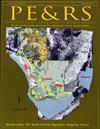一种用于高光谱降维和分类的增量Isomap方法
IF 2
4区 地球科学
Q4 GEOGRAPHY, PHYSICAL
引用次数: 1
摘要
许多流形学习算法对大小为N×N的数据相似性矩阵进行特征向量分析,其中N是数据点的数量。因此,分析的存储器复杂性不小于O(N2)。在本文中,我们提出了一种增量流形学习方法来处理用于土地利用识别的大型高光谱数据集。在我们的方法中,高维高光谱图像数据集的维数是通过训练数据集获得的。利用局部曲率变化算法对数据点的子集进行采样,作为地标。然后,基于地标来识别流形骨架。我们的方法在三个AVIRIS高光谱数据集上进行了验证,优于使用k–近邻分类器的比较算法,并使用支持向量机获得了第二好的性能。本文章由计算机程序翻译,如有差异,请以英文原文为准。
An Incremental Isomap Method for Hyperspectral Dimensionality Reduction and Classification
Many manifold learning algorithms conduct an eigen vector analysis on a data-similarity matrix with a size of N×N, where N is the number of data points. Thus, the memory complexity of the analysis is no less than O(N2). We pres- ent in this article an incremental manifold
learning approach to handle large hyperspectral data sets for land use identification. In our method, the number of dimensions for the high-dimensional hyperspectral-image data set is obtained with the training data set. A local curvature varia- tion algorithm is utilized to sample a subset
of data points as landmarks. Then a manifold skeleton is identified based on the landmarks. Our method is validated on three AVIRIS hyperspectral data sets, outperforming the comparison algorithms with a k–nearest-neighbor classifier and achieving the second best performance with support
vector machine.
求助全文
通过发布文献求助,成功后即可免费获取论文全文。
去求助
来源期刊

Photogrammetric Engineering and Remote Sensing
地学-成像科学与照相技术
CiteScore
1.70
自引率
15.40%
发文量
89
审稿时长
9 months
期刊介绍:
Photogrammetric Engineering & Remote Sensing commonly referred to as PE&RS, is the official journal of imaging and geospatial information science and technology. Included in the journal on a regular basis are highlight articles such as the popular columns “Grids & Datums” and “Mapping Matters” and peer reviewed technical papers.
We publish thousands of documents, reports, codes, and informational articles in and about the industries relating to Geospatial Sciences, Remote Sensing, Photogrammetry and other imaging sciences.
 求助内容:
求助内容: 应助结果提醒方式:
应助结果提醒方式:


